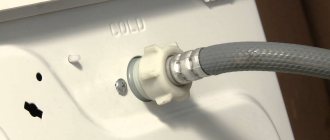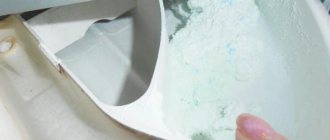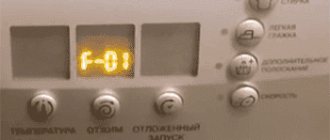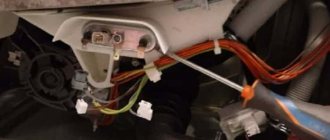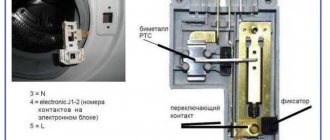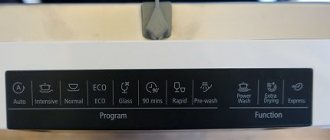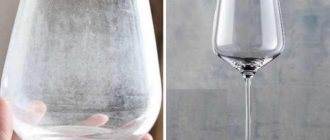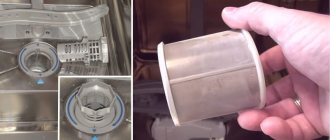- Causes of internal problems
- Methods for removing contaminants
- Prevention
Today, the dishwasher has become firmly established in the life of a modern person. Many people can’t imagine a kitchen without it, and for single people or families with small children it’s just a godsend. But sometimes this discovery fails, and then the question arises - how to clear the blockage in the machine? This article will discuss exactly why a clog occurs in the dishwasher and what to do about it.
Let's imagine that you had a hearty dinner, loaded the dishes into the machine, turned it on and decided to go relax. Suddenly, after a while, the unexpected happened - your assistant started working as usual, but she couldn’t finish the wash. There is soapy water in the car and silence instead of the usual sound of a running pump.
The dishwasher is clogged
And sometimes there is not silence, the machine seems to be trying to work - it squeaks, groans, but, unfortunately, it cannot do anything without your help. What happened? Most often, the cause of such an unexpected breakdown is a blockage. There are different types of blockages: external and internal.
External blockages include a clogged drain in the apartment or a kinked drain hose. This clog can be corrected by disconnecting the dishwasher from the drain and cleaning the drain pipes using chemicals or mechanically using a wire. Often the machine is connected to the same system as the sink, and if the water does not drain well from the sink, then the machine will eventually begin to act up and become clogged.
A kink in the drain hose is often due to improper installation, but can be corrected by straightening the bend and connecting it back to the machine. Do not forget to disconnect the dishwasher from the power supply before performing any manipulations.
What is causing the malfunction?
There are several main reasons that can prevent drainage. These can be either mechanical problems or disruptions in the operation of the control center.
Attention! Before carrying out an initial inspection of the device, you must disconnect it from the direct power source, in accordance with the rules of safe operation.
Blockages in the following components can interfere with the smooth operation of the dishwasher:
- apartment sewer system
- internal removable filter
- drain pipe system
- filter in the water supply valve
- drain pump
- blade elements.
Before carrying out diagnostics, you need to make sure that there are no obstacles to the drainage of waste water due to a kink in the dishwasher drain hose.
Folk remedies
Soda
Baking soda removes old stains and eliminates unpleasant odors. You need to pour soda into the tray of the machine, then turn it on at the highest temperature for a short time.
Vinegar
Effectively disinfects equipment and removes dirt and grease. To do this: fill a plate with vinegar (preferably use distilled white vinegar) and place it on the top shelf. Turn on the device at maximum power. After work, leave the door open to eliminate the unpleasant odor.
Lemon acid
Will help in the fight against scale. Pour 300 g of acid into the machine and run it at full power.
To keep your kitchen appliances in working order, you need to know how to clean a dishwasher at home. The answer to the question must be found in the operating instructions for the device. The manufacturer lists the detergents and cleaning products that are allowed. Budget models, unlike automatic ones, are subject to exclusively manual cleaning. At the same time, you need to remember that you should not rely entirely on automation.
During the first month of operation, the inner surface of the device is covered with a layer of fat. If you do not clean it promptly, then after a few weeks you will need to contact a service center. In most cases, maintenance is performed using a limited list of substances, the use of which inside the unit will not cause harm to it. Unfortunately, not everyone is in a hurry to get acquainted with it. As a result, the number of equipment failures increases.
The first thing the housewife should remember is that you should not use aggressive chemicals and acids. Even if labeled “delicate,” the reagent can still damage the interior surface. The second rule concerns the amount of substance used. Jewelry precision is the key to long-term health of the dishwasher.
The following tips will help you avoid many problems at the stage of practical operation:
- It is recommended to ventilate the unit after each use - this reduces the rate of formation of fatty deposits;
- The thicker the layer of fat inside, the less time you can dry the dishes;
- After completing the sanitary measures, the “insides” of the machine must be dried for at least 40 minutes, otherwise mold will form.
Regularity and consistency are the key to a healthy dishwasher. You can get rid of fat using the recommended list of substances. They are poured into a tank specially designated for this purpose, after which the “cleaning” mode is activated. The main thing is to quickly remove fatty deposits that can harm the mechanical elements of the device.
How to eliminate the causes yourself?
Each of the breakdown options has its own simple solutions, which you can try to cope with yourself. Before starting repairs, you must carefully read the instructions for the machine and unplug the power cord from the outlet. Then remove the drain hose from the sewer and lower it into a bucket. If liquid suddenly gushed out in a sharp stream, then the most likely cause of the blockage is a clogged sewer or drain. If water still remains in the dishwasher, you need to look for the cause further by first collecting it manually and draining the internal tank.
Kink in the drain hose. During general cleaning of the apartment and direct care of the unit itself, its location may temporarily change. Therefore, the drain hose can bend anywhere and prevent water from flowing freely. You need to carefully inspect it for correct installation and correct the position.
Sometimes the hose becomes clogged with mechanical debris (bones, solid food particles) and loses its capacity. Then you need to disconnect it from the dishwasher and remove it from the connection to the sewer and rinse it under strong water pressure.
Poor water pressure. If there is poor pressure in the city water supply system, then it will enter the device in insufficient quantities and can cause a general malfunction of the electronic module. The wash cycle will not start correctly and the sequence of commands may be incorrect.
Clogged sewer in the apartment. If the device has a common outlet with a sink and water does not drain well from there, then you need to try to eliminate the mechanical blockage using special chemicals such as “Mole” or a cable for cleaning the sewer system. Most often, the root cause of poor water drainage in such cases is pipes clogged with plugs of hair, congealed fat or food debris.
A blockage in the general sewer system in an apartment building or private building will also prevent the direct outflow of water. It’s very simple to understand this - not only the water from the kitchen appliances does not drain, but, in general, everything in the house.
Drain filter clogged. Almost always, users of household appliances neglect manufacturers' recommendations for operation. The device is not properly maintained and this leads to failure. When using a dishwasher, the manufacturer strongly recommends cleaning cutlery from any uneaten food particles before putting it in. Otherwise, they heavily clog the fine mesh of the internal filter and prevent the waste liquid from draining. This problem is quite easy to deal with. You just need to take out the removable filter, clean it under running water and install it back.
Clogged blades most often occur due to poor quality of city water. When it is very hard, the small outlet holes become clogged with limescale and the flow of water goes in the wrong place. It is necessary to remove the blades, clean them with a toothpick, rinse them under a strong stream and insert the impeller back.
Drain pump clogged. When the internal drain is clogged, water sits in the internal tank and does not drain through the drain hose. If all of the above measures do not help, then the cause may be the drain pump. You can find its location by carefully studying the instructions. You should unscrew the protective cover and try to rotate the pump blades with a stick or pencil. When movement is difficult, you should try to remove the foreign object and screw the pump back in.
Attention! Under no circumstances should you touch the blades with your fingers. Typically, the cause of a mechanical stop of the pump is pieces of broken dishes. Contact with them will result in cut wounds to the hands.
Decoding the e25 code on the dishwasher display - read more in our article.
How to clean the dishwasher filter if it is clogged
It often happens that dishwasher filters become dirty. This significantly complicates the operation of the device and reduces the quality of washing. If the blockage is not cleared in a timely manner, it may lead to damage to the device. Cleaning your dishwasher filter periodically will help avoid many problems.
How to clean the filter?
Causes of filter clogging
The main reason is large food residues on the dishes. Before loading dishes, you should thoroughly clean the plates from any remaining food and be sure to rinse them with warm running water.
But even this event will not completely eliminate the possible clogging of the filter, because fat accumulates on it, which does not completely dissolve in water. Detergent residue can also cause clogs. Scale and plaque also leave their mark on the surface of this element.
How to remove the filter
In household Bosch or Electrolux dishwashers, the filters are located in the lower internal part of the device, above them there are rocker arms for distributing water and a heating element. The structure of a Bosch dishwasher is shown in the photo.
Before removing the filter for cleaning, you should unplug the device from the power supply, then use a sponge or rag to collect excess water. Only then can you remove the filter itself. By the way, the remaining parts - water distributors, heating element - should also be cleaned of scale and other contaminants.
It is very easy to understand that the filter is clogged and requires immediate cleaning. The machine begins to work much worse than before. The quality of dishwashing decreases, the appliance begins to make some noise, and water remains at the bottom. All this indicates that it is time to urgently clean the filter.
How can you clean the filter?
There are several available ways to clean the filter in your dishwasher:
- Using dishwashing detergent and cleaning powder. They can be applied using an old toothbrush, then rinse thoroughly with running water, and the procedure can be repeated if necessary.
- Another effective remedy that will help get rid of fat is baking soda. It can be used along with table salt, which also helps clear grease stains. But it’s better to dilute the powder with water and apply the slurry with a dishwashing sponge, then rinse.
- The last method, which will help not only get rid of fat, but also limescale, is citric acid; for this, the part should be soaked in the solution for several hours, then washed with soapy water. Vinegar works in a similar way. If there is no citric acid, it will completely replace it.
It often happens that the filter located on the water supply valve becomes clogged. You should not forget about cleaning it, even if not too often.
The water that passes through it every day is not of high quality. It may contain a lot of salts or lime. Sometimes rust particles come out of the pipes.
If the dishwasher filter is not cleaned on time, the water will draw in much more slowly.
Preventive measures
A few simple rules will help avoid many problems:
- All food residues should be removed from dishes before loading them into the machine. It is advisable to rinse it with warm water to partially remove the grease.
- To wash dishes, you must use special liquids, powders or tablets; A household product will not work.
- It is advisable to use special water softeners - this will reduce the accumulation of scale on the heating element and water distributors.
- The filter must be removed and washed at least once every two weeks. And once every three months you should carry out a general cleaning inside the device, because dirt and grease accumulate throughout the entire internal surface of the machine, which causes an unpleasant odor and the formation of fungus.
It is advisable to clean the dishwasher filter and clean the inside of the appliance as often as possible. Anyone can do this on their own.
All these measures significantly extend the life of the equipment and help avoid the need for expensive replacement of some parts and components.
In the video you can see detailed instructions for cleaning the dishwasher filter from clogging.
Special cases
None of the measures taken help? What to do in this case? Call the master! Most likely, some control element has failed. Only a qualified technician can identify such a breakdown and replace it with a new one.
Incorrect operation of the software module. When the electronic “brain” incorrectly analyzes the operation of the device and sends incorrect programs through the control module, the outflow of water may stop. Such a failure can be diagnosed only with special devices. The failure can be corrected by reflashing and replacing the unit with a new one. This is the most expensive type of dishwasher repair work and the risk of causing serious harm when repairing it yourself is quite high. Checking the operation of the electronic unit is the prerogative of an employee of a specialized service center.
Damage to the water level sensor. The force of water pressure inside the dishwasher is measured by a special device - a pressure switch. They come in two types - electronic and mechanical and do not come into direct contact with water during operation. All measurements are carried out through a special air membrane and fed to the sensor. The cause of failure of the unit may be oxidation of the contacts, a puncture in the pressure switch tube, the ingress of detergent into it, or a manufacturing defect. Diagnosis of a breakdown is carried out using a multimeter, so calling a qualified technician is a necessity, not a whim.
Getting rid of limescale
When caring for your machine, you need to decide not only how to clean it from grease, but also how to get rid of scale.
. The heating elements are inaccessible for direct contact; disassembling the machine to gain access to them from the inside is strictly not recommended. Scale can only be dealt with using chemicals. The products can be either specialized, purchased in a store, or “homemade,” that is, from improvised ingredients.
Professional anti-scale products
To remove scale, acid-based products are used, which, by triggering a chemical reaction, destroy the plaque on the heating elements.
The most popular dishwasher detergents are “Fairy” and “Finish”
.
- “Fairy” (or “Fairy Platinum”) is available in the form of a gel or tablets with inclusions that prevent the appearance of scale and the spread of rust.
- “Finish” is a gel-like preparation produced in 250 ml bottles. The container with the product should be placed in the dishwasher and run a cycle with a water temperature of 60−70°C.
Both products have already received many rave reviews from dishwasher owners.
Many people complain about the poor quality of various tablets: the dishes are not washed, smudges remain, and the product itself remains on the plates and cups. But Fairy capsules do a great job: in 40 minutes they perfectly wash simple dishes, frying pans, and frying pans with grease build-up.
Irina, 32 years old.
I like Fairy All in 1: these are capsules with powder and gel. The white powder is the actual detergent, and the gel is a rinse and water softener. After them, the dishwasher shines, and there is no need for special cleaning.
Sofia, 35 years old.
I have a Bosch dishwasher, which after three years has become terrible at cleaning dishes. I bought Finish and followed the instructions: I removed all the dishes, removed the sticker, turned them upside down and placed them at the very bottom. The cycle started as long as possible, with a temperature of 65 degrees. When the cycle ended, the machine smelled pleasantly of lemon, and the dishes now clean perfectly again!
Nastya, 28 years old.
Remedies for plaque from scrap materials
The price of professional anti-plaque products seems exorbitant to some.
. Thrifty housewives can resort to home remedies that will effectively help clean the dishwasher.
Choosing a specific cleaning product is the right of every housewife. The main thing is not to neglect the rules of caring for equipment and not to ignore symptoms indicating contamination:
- A louder pump sound indicates that the filter is dirty.
- Poorly washed dishes indicate the presence of blockages and deposits on the baskets and blades.
- An unpleasant smell, red and black spots on the door are a sign that grease has reached the secluded corners, the seals are overgrown with dirt, and the machine itself needs to be dried more often.
Grease, dirt and residue make the dishwasher ineffective. Take care of it carefully, and then the equipment will last a long time.
Attention, TODAY only!
Good afternoon, dear readers. Quite often I have to deal with such a problem as customer complaints regarding malfunctions in dishwashers. Often, excited and angry people come to the store to return goods because they were allegedly sold a low-quality product, without even realizing that they themselves have become a “stumbling block” for expensive equipment
The reason for this may be improper care, which is why it is so important to know how to clean a dishwasher at home, which will be discussed in today’s article
Preventive measures
Any malfunction is cheaper to prevent than to fix. Preventive measures are the first and most important way to protect kitchen appliances from troubles such as breakdowns. With proper operation according to the advice from the manufacturer, you can avoid many unexpected emergency situations. Following simple rules will save you from headaches, wasted nerves and money:
- You need to regularly clean the mesh filter inside the main chamber of the device.
- When loading dishes into the machine, it is worth inspecting and periodically clearing blockages in the nozzles of the blades and the place where they are attached.
- Two or three times a year it is worth checking, removing and cleaning the inlet and outlet filters on the water supply and drain hoses with plain water.
- Before loading, clean dishes from any remaining paper napkins, labels, or pieces of food.
- It is necessary to use a special softening salt for hard city water to prevent the formation of limescale.
- Avoid getting excess moisture and grease on the dishwasher control panel.
Worth remembering! Once a month you need to wash it with a special anti-alkaline agent. As an alternative, people have long used citric acid for these purposes. It is necessary to pour the powder into the detergent compartment and run it “idle” at the highest temperature setting. This measure effectively gets rid of hard, greasy deposits inside the water supply and drainage system. It will also help protect the heating element from scale and premature failure.
The best way to protect yourself from questions about how to clear a clog in your dishwasher is to handle it with care and precision! Then it will serve for many years without failures or major repairs. If handled correctly, it can seriously simplify the difficult life of housewives and eliminate the exhausting daily washing of large quantities of dirty dishes.
There is no need to save once on calling a specialist from the service center, so as not to increase material costs for repairs in the future.
On our website you can also read about troubleshooting dishwashers with code e22.
How to remove scale, grease and blockages using traditional methods
One day a customer came to our electronics store who bought a dishwasher from us about six months ago. She threw a real scandal, saying that we sold her defective equipment, which so quickly began to function poorly. To help you understand the situation, dirt is no longer completely removed from the dishes.
The lady began to demand the return of money for the goods or payment for the repair of a broken car. Then I had to ask the customer a counter question: how often did you clean such an expensive device, did you use special products, and how often did you use them? The answer simply infuriated me. She said she often used the tablets to clean dishes and the dishwasher.
That is, in six months of operation the hose, drain or filter has never been cleaned. Then I had to remind the woman once again about the frequency of “hygiene” of equipment and talk about an effective folk remedy against scale, which every housewife can find in her kitchen. You can effectively clean scale at home with citric acid. To do this, you will need 200-400 grams of acid, which needs to be poured into the dishwasher, after which you need to start the normal dishwashing mode. Just a few days later, the customer came with words of apology and thanked her for the useful advice.
If you don’t want to find yourself in the same awkward situations, then you should pay more attention to technology and take note of several popular methods for cleaning your dishwasher from scale, grease and clogs.
- As you already understood, the first remedy is citric acid. It perfectly removes scale, blockages in the drain and greasy build-ups on important elements. The only rule when using such a “hot” product is to rinse the device again using the normal washing mode to completely remove any remaining lemon juice.
- The second option is lemon juice. In order to get rid of fat on the door and rubber bands, just squeeze out the juice of 3 fruits and wipe the indicated elements with it, then wipe them dry.
- Another effective remedy for scale and blockages is vinegar. To clean with vinegar, you will need to pour 400 ml of the product into the bottom of the basket, turn on the unit to heat the water, start the device and stop it approximately halfway through the cycle. If the blockage is minor, you can continue the washing process after 30 minutes. If you need to get rid of a more serious blockage, then leave the machine in this state overnight and finish the cycle in the morning.
- A riskier method is bleach. If the internal parts of your dishwasher are made of stainless steel, then you will have to abandon this product immediately. If not, know that bleach is a great way to combat mold. To do this, you need to pour 200 ml of the solution into the dishwasher and run a full wash cycle at high temperature.
Don’t forget about preventing the occurrence of fat deposits, unpleasant odors, and scale. “Fairy”, “Fairy Platinum” (soda tablets), “Antinakin” or “Finish” for dishwashers can help you with this.
Remember that poor performance or breakdown of equipment is often caused by improper care. Hopefully, after reading this article, you will become more diligent about taking care of your dishwasher and can affordably clean it yourself. By the way, don’t forget about your other friends from the world of technology, for example. Subscribe to updates, invite friends and always be the first to know the news of the technology world.
Fighting mold and rust
If mold and scale forms, you must perform the following actions:
- Using a product with a bleaching effect (1 glass per 2 liters of water), clean the inside of the device;
- remove scale with a sponge and solution, diluting half a glass of ammonia with 4 liters of water;
- At the end of the procedure, start the rinse mode.
If rust has formed on the coating of a basket for metal objects, it is better to replace the component or coat it with a special sealant paint. If the reason is rusty pipes, the only solution is to replace them. When water with a high iron content comes into your taps, try installing filters to remove impurities from it.
Idle start
If you once open the door of your “home assistant” and find that there is a thin film of greasy residue left on the bottom of the washing chamber, take action. You shouldn’t wait until fat accumulates in a thick layer at the bottom and you have to figure out how to get rid of it. When there is little grease, run the dishwasher dry. What does it mean?
- We open the dishwasher door and take out everything unnecessary: dirty dishes, dish baskets, cutlery trays.
- We put powder or a dishwashing tablet into the cuvette (depending on what you use). These products contain concentrated anti-fat compounds. In the absence of dirty dishes, they will dissolve grease on the walls of the washing chamber, inside the garbage filter and in other places.
- Close the door and start washing the dishes in hot water, at least 60C. The program must last at least 3 hours.
- At the end of the wash, we open the door and stuff everything that we previously pulled out of there into the washing chamber.
These simple “bath procedures” allow you to effectively clean the dishwasher from the inside. Most often, this is enough to completely get rid of fat, but only on the condition that you do such procedures regularly. If the machine has not been cleaned for a long time, you should resort to another method.
Manual cleaning
You can only clean your dishwasher of old grease at home by hand. And there’s no need to explain anything special here, you understand everything yourself. If you wash greasy dishes and then leave the machine alone for 1-2 weeks, the remaining grease will dry onto the parts of the equipment. A hard layer is formed that is not so easy to dissolve. The only way is to clean it by hand.
You can clean the inside of the dishwasher using any convenient brush and some good fat-dissolving chemicals. The cleaning technique is clear to everyone, you apply the product to the brush and go ahead.
Pay attention to hard-to-reach places where fat settles in large quantities:
- under and around the lower sprinkler arm;
- on the sprinkler impeller;
- in the garbage filter;
- on the trash filter grille;
- in the corners of the washing chamber;
- at the bottom of the rear wall of the washing chamber.
Drying dried-on grease is still a pleasure, but you will get a feel for what it is, and from now on you will wash the dishwasher on time. You can apply dishwashing detergent to the inner surfaces of the washing chamber an hour before cleaning, then the work will go easier.
We use special chemistry
It is best to use special dishwasher cleaning products. Dishwasher repair specialists recommend regularly using such chemicals to prolong the work of “household assistants”. However, when purchasing such chemicals, make sure that the manufacturer is well-known and the price is not too low. Sometimes, under the guise of dishwasher cleaning agents, they sell aggressive chemicals that are dangerous to equipment and human health.
When figuring out how to clean the dishwasher, people take regular vinegar and pour it in excessively, hoping that it will destroy all the dirt. In fact, vinegar does not remove all dirt, at the same time causing damage to machine parts, so we recommend either not using it at all, or using it rarely and in a small concentration.
The proprietary composition for cleaning the dishwasher is very simple to use. It is enough to pour it into the powder or tablet compartment, select a long washing program, remove dirty dishes from the washing chamber and start the program. When the program ends, the machine will be cleaned from the inside.
So, cleaning your machine from grease is not always easy. Sometimes this is difficult but necessary physical labor.
It is important to remember one thing: the more often you clean your “home assistant” of fat, the easier it is to do it. If you forget about “bath procedures” a couple of times, the equipment will become covered with dirt, and this will mean the most unpleasant thing - manual cleaning
Share your opinion - leave a comment
